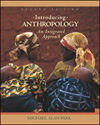 |  Introducing Anthropology: An Integrated Approach, 2/e Michael A. Park,
Central Connecticut State University
Table of ContentsPart One. Background and ContextChapter 1. Doing Anthropology: Taking Fingerprints in the High Plains
In the Field
The Hutterites
Anthropology
Contemporary Issues: What Responsibilities Does the Anthropologist Have When Studying Other Cultures?Chapter 2. Methods of Inquiry: Anthropology as Science
The Scientific Method
Belief Systems
Anthropology as a Science
Contemporary Issues: Isn't Science Sometimes A Threat to Society?Chapter 3. Evolution: Change in Nature and the Nature of Change
The Evolution of Evolution
Adaptation
Descent with Modification
The Origin of Species
Contemporary Issues: Is Evolution a Fact, a Theory or a Hypothesis?Part Two. The Identity and Nature of Our SpeciesChapter 4. Our Place in Nature: Humans as Primates
Naming the Animals
Into the Trees
Contemporary Issues: Should Nonhuman Primates Have Rights?Chapter 5. Anatomy and Physiology: The Bipedal Primate
Out of the Trees
Around the World
Contemporary Issues: Have We Found the “Missing Link”?Chapter 6. Reproduction: The Sexual Primate
Sex and Genetics
Sex and Human Evolution
Vive la Différence
Sex and Gender
Sex and Cultural Institutions
Contemporary Issues: What Causes Differences in Sexual Orientation?Chapter 7. Learning How to Survive: The Cultural Primate
The Concept of Culture
Brains and Culture
A Model for the Study of Cultural Systems
An Anthropological Analysis of the Necktie
Contemporary Issues: Can Anthropologists Study Their Own Cultures?Part Three. Adapting to Our WorldsChapter 8. Food: Getting It, Growing It, Eating It, and Passing It Around
Food and Human Evolution
Food Collecting Societies
Food Producing Societies
Some Basic Economics
Contemporary Issues: Is There a World Population Crisis That is Putting Pressure of Food and Other Resources?Chapter 9. Nature of the Group: Arranging Our Families and Organizing Our People
Primate Societies
Kinship
Kinship Terminology
Organization Above the Family Level
Contemporary Issues: Why Don't Bilateral Societies Have Equality Between the Sexes?Chapter 10. Material Culture: The Things We Make and the Things We Leave Behind
Archaeology: Recovering and Interpreting the Cultural Past
Some Prehistoric High Points
Contemporary Issues: Who Owns Archaeological Sites and Their Contents?Chapter 11. Communication: Sharing What We Need to Know
Language
Language and Evolution
Language and Culture
Contemporary Issues: Are Written Languages More Advanced Then Unwritten Ones?Chapter 12. Maintenance of Order: Making the World View Real
Religion and Religious Systems
Religion and Culture
Law
Contemporary Issues: How Can We Account for the Recent Interest in Witchcraft?Chapter 13. The Evolution of Our Behaviors: Pigs, Wars, Killer Proteins, and Sorcerers
So What's Wrong with Pork?
Peaceful Warriors and Cannibal Farmers
Biology and Culture in Interaction
Contemporary Issues: Are Humans Naturally Violent?Part Four. The Species Today, The Species TomorrowChapter 14. Human Variation: Different Looks, Different Behaviors
Why Are There No Biological Races with the Human Species?
What, Then, Are Human Races?
Race, Racism, and Social Issues
Contemporary Issues: Are There Racial Differences in Athletic Ability?Chapter 15. Culture Change: Processes and Problems and the Contributions of Anthropology
The Processes of Culture Change
Theories of Cultural Evolution
Change in the Modern World
Applying Anthropology
Contemporary Issues: Can Anthropology Be Both Scientific and Humanistic in Today's World?Chapter 16. State of the Species: The Edge of the Future
The Human Species Today
The Human Species in the FutureGlossary
Bibliography
Index
|
|



 2002 McGraw-Hill Higher Education
2002 McGraw-Hill Higher Education